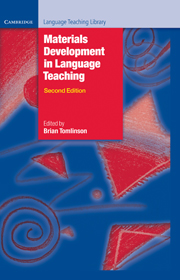Book contents
- Frontmatter
- Contents
- Preface
- Glossary of basic terms for materials development in language teaching
- Acknowledgements
- 1 Introduction: principles and procedures of materials development
- Part A Data collection and materials development
- 2 Using corpora in the language classroom
- 3 Concordances in the classroom without a computer: assembling and exploiting concordances of common words
- 4 Telling tails: grammar, the spoken language and materials development
- Comments on Part A
- Part B The process of materials writing
- 5 A framework for materials writing
- 6 Writing course materials for the world: a great compromise
- 7 How writers write: testimony from authors
- Comments on Part B
- Part C The process of materials evaluation
- 8 The analysis of language teaching materials: inside the Trojan Horse
- 9 Macro- and micro-evaluations of task-based teaching
- 10 What do teachers really want from coursebooks?
- 11 The process of evaluation: a publisher’s view
- Comments on Part C
- Part D The electronic delivery of materials
- 12 Developing language-learning materials with technology
- 13 New technologies to support language learning
- Comments on Part D
- Part E Ideas for materials development
- 14 Seeing what they mean: helping L2 readers to visualise
- 15 Squaring the circle – reconciling materials as constraint with materials as empowerment
- 16 Lozanov and the teaching text
- 17 Access-self materials
- Comments on Part E
- Conclusions
- Recommended reading
- Index
Comments on Part C
Published online by Cambridge University Press: 09 February 2023
- Frontmatter
- Contents
- Preface
- Glossary of basic terms for materials development in language teaching
- Acknowledgements
- 1 Introduction: principles and procedures of materials development
- Part A Data collection and materials development
- 2 Using corpora in the language classroom
- 3 Concordances in the classroom without a computer: assembling and exploiting concordances of common words
- 4 Telling tails: grammar, the spoken language and materials development
- Comments on Part A
- Part B The process of materials writing
- 5 A framework for materials writing
- 6 Writing course materials for the world: a great compromise
- 7 How writers write: testimony from authors
- Comments on Part B
- Part C The process of materials evaluation
- 8 The analysis of language teaching materials: inside the Trojan Horse
- 9 Macro- and micro-evaluations of task-based teaching
- 10 What do teachers really want from coursebooks?
- 11 The process of evaluation: a publisher’s view
- Comments on Part C
- Part D The electronic delivery of materials
- 12 Developing language-learning materials with technology
- 13 New technologies to support language learning
- Comments on Part D
- Part E Ideas for materials development
- 14 Seeing what they mean: helping L2 readers to visualise
- 15 Squaring the circle – reconciling materials as constraint with materials as empowerment
- 16 Lozanov and the teaching text
- 17 Access-self materials
- Comments on Part E
- Conclusions
- Recommended reading
- Index
Summary
The obvious link between the different chapters in Section 3 is their insistence on the need for more feedback (and for more systematic feedback) from materials users to materials producers. All too often major decisions are made about the content, approach, procedures and design of learning materials based on assumptions of user needs and wants and on impressions of what ‘works’ in the classroom. Often these assumptions and impressions are illusory, misinformed or unrepresentative and mistakes are made which contribute to dissatisfaction and failure. One of the things that always amazes me is that, as I travel around the world meeting teachers at conferences and workshops, the impression I am given is that most teachers are dissatisfied with the materials available to them. Yet publishers and ministries tell me that their impression is that the teachers are basically satisfied with these same materials. I suspect that both impressions are wrong because they are based on unrepresentative samples of teachers and because of the ways in which the impressions were gained. Many teachers who come to conferences and workshops are untypically knowledgeable, enthusiastic and discerning. If given a chance to express their views to somebody like me, who does not represent a publisher or authority and who is keen on the development of innovative materials, they are more likely to tell me what they do not like about their materials than what they do like. On the other hand, teachers, when being interviewed by publishers or officials (or even when responding to their questionnaires), are more likely to be polite and/or cautious and to incline more towards the positive in their responses (see Chapter 11 in this volume by Frances Amrani and Singapore Wala 2003a , 2003b ). Both my impressions and those of the ‘authorities’ are often not only misleading, but they are also too crude to be informative. What we need is fine-tuned information about the outcome of materials use in terms of what the teachers and learners actually did, what they felt about what they did and what the consequences were of what they did.
- Type
- Chapter
- Information
- Materials Development in Language Teaching , pp. 296 - 300Publisher: Cambridge University PressPrint publication year: 2011
- 1
- Cited by

